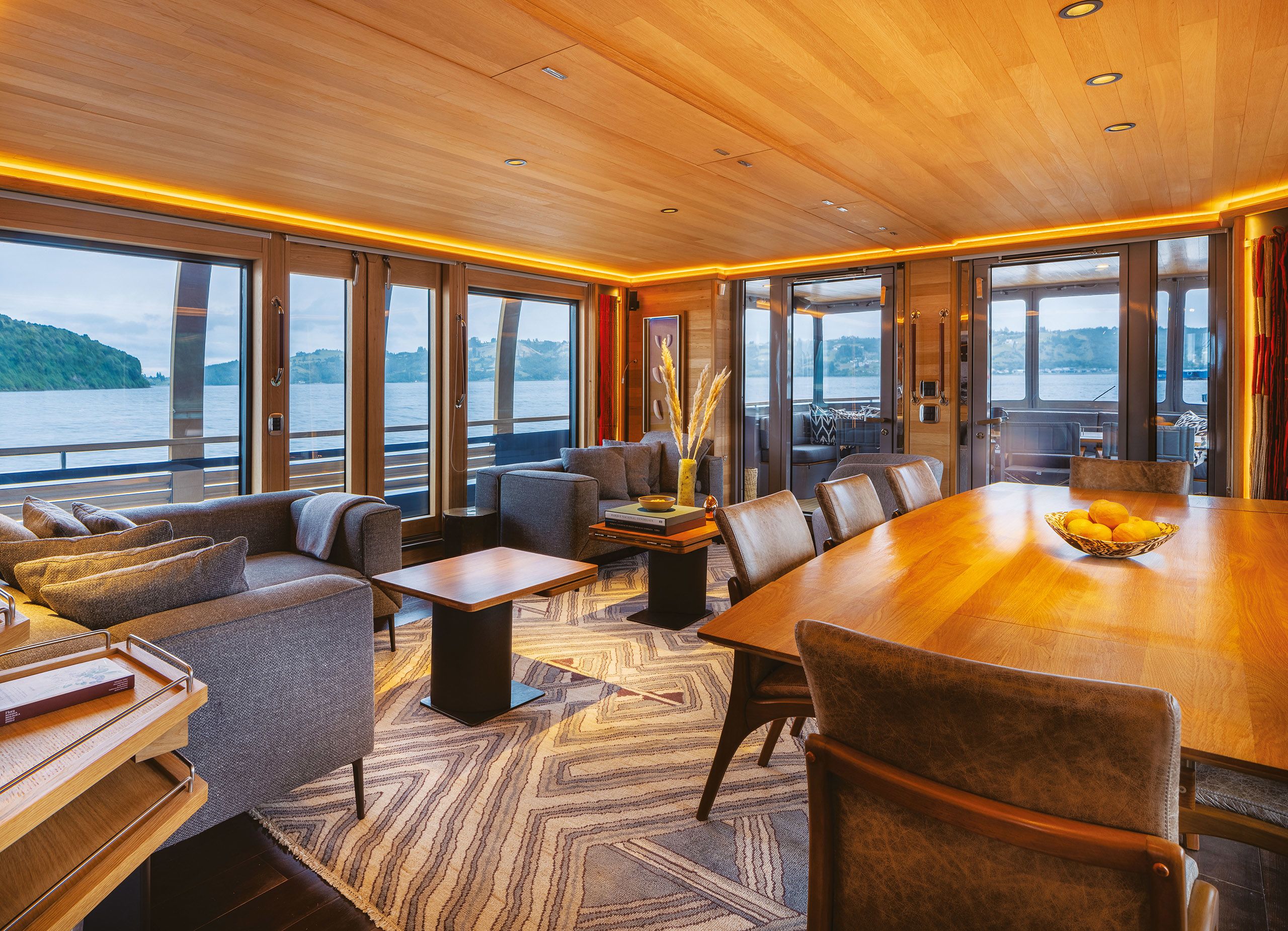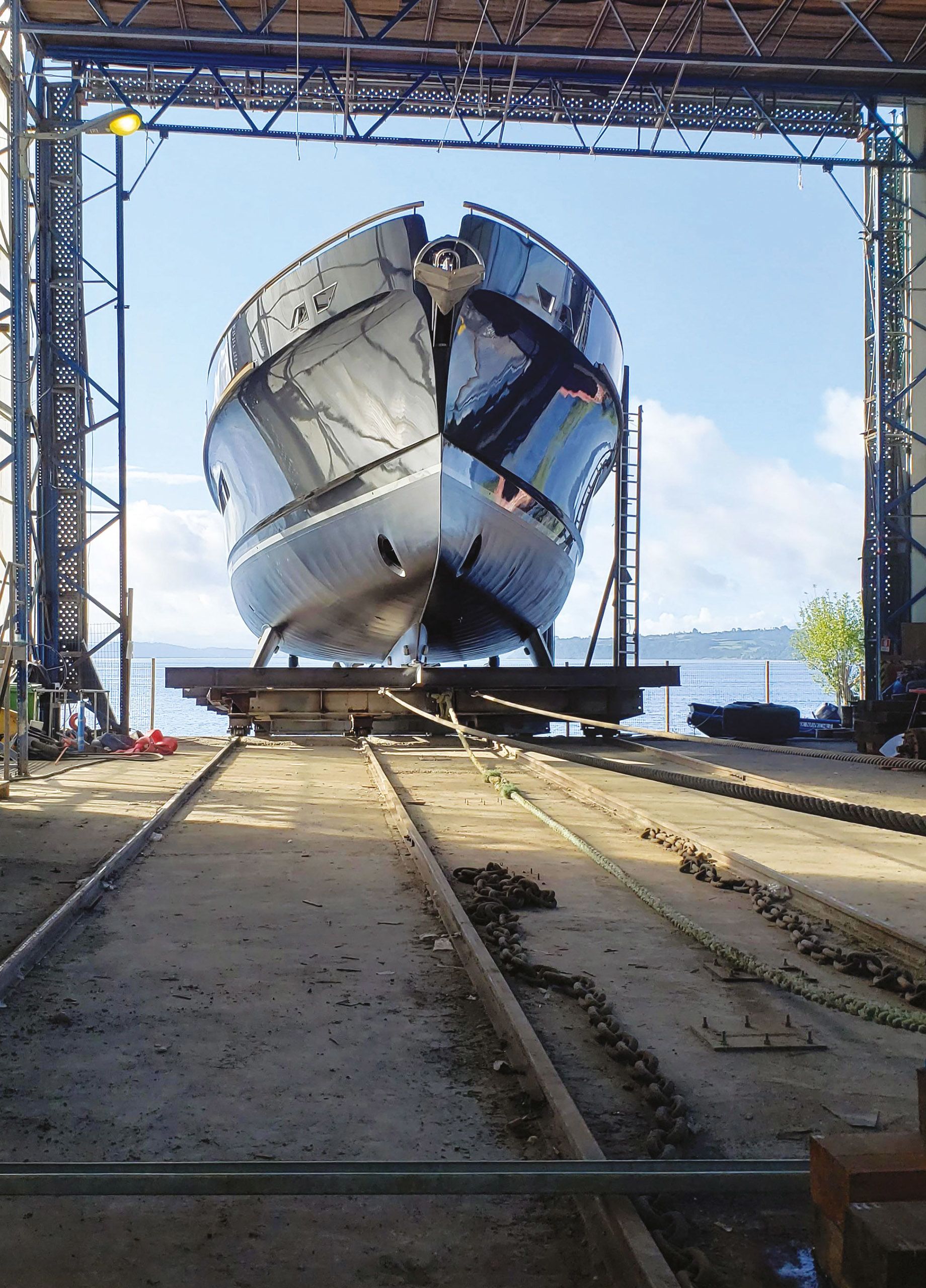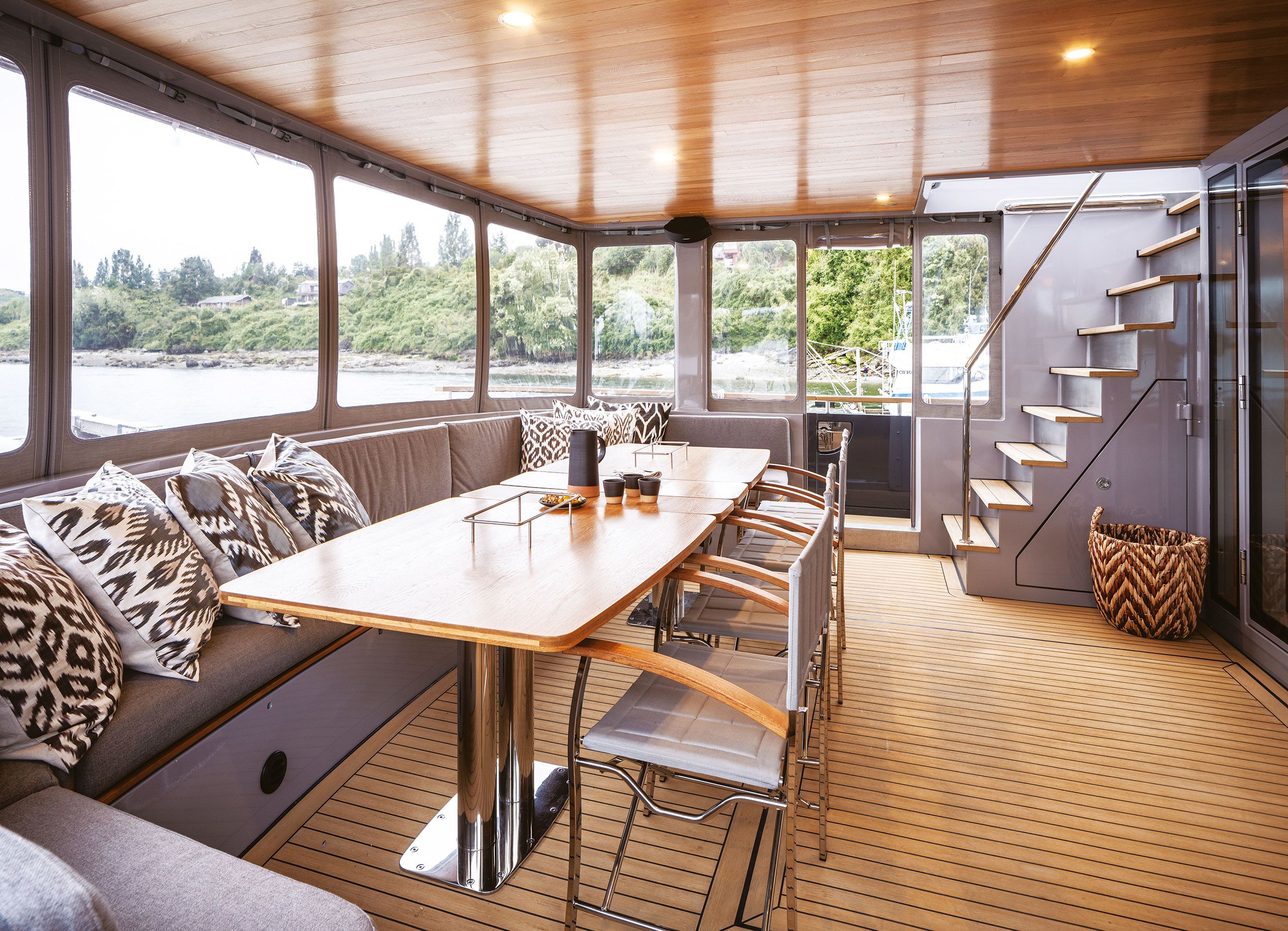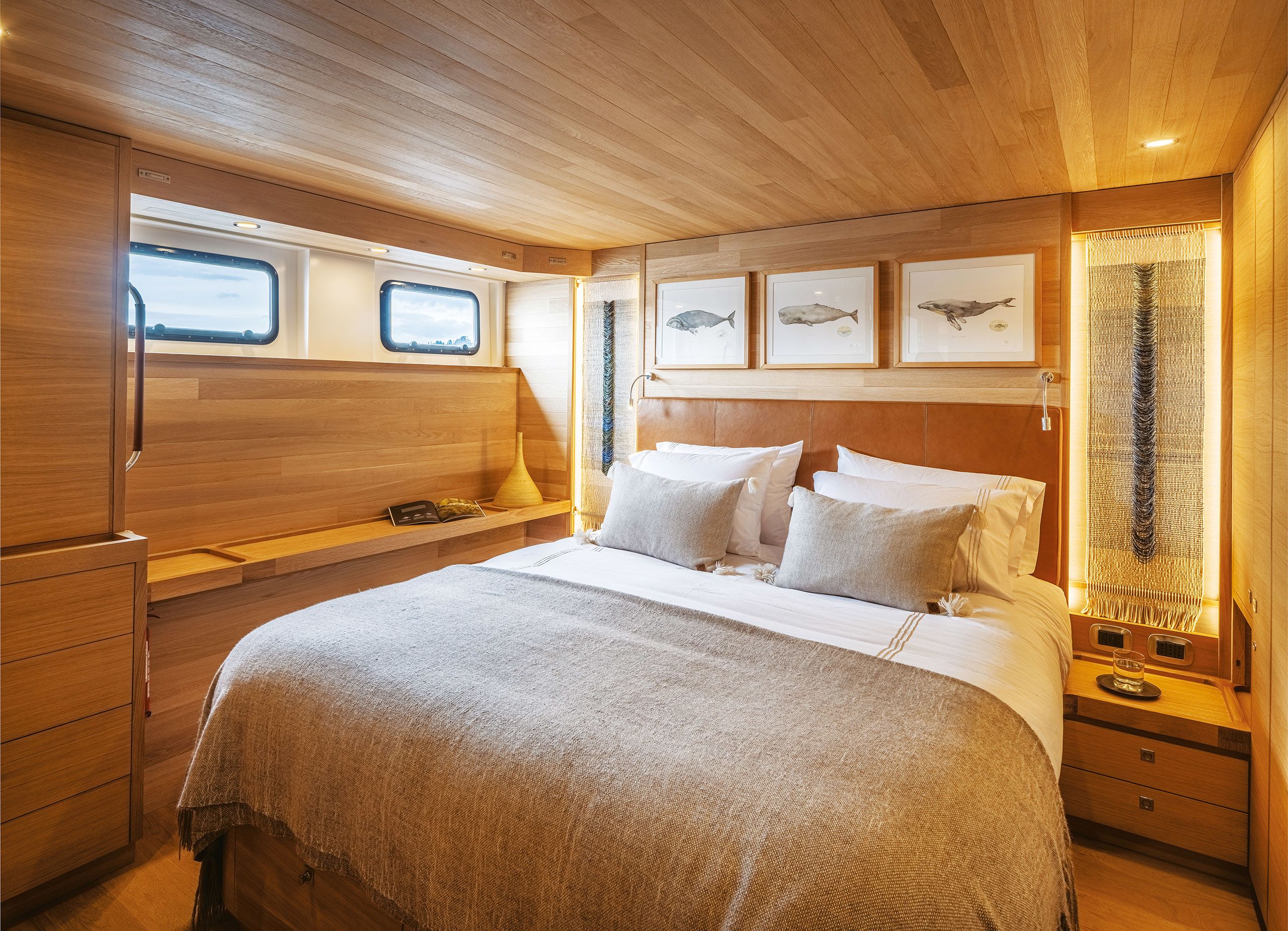SOUTHERN STAR
The fascinating story behind the Chilean-built Patagonia Explorer 80, Cachalote

Bespoke, sustainable and tough, the first large explorer from Navik Patagonia has taken on the tricky waters around Chile with aplomb. Julia Zaltzman delves into the fascinating story behind the Patagonia Explorer 80
MARCOS ZEGERS
“How is it possible for Chile to have lost its oceanic culture?” asks ocean conservationist Francisca Cortés Solari, as if baffled by her own question. Chile has 6,500 kilometres of Pacific Ocean coastline running the entire length of its western side, counts Rapa Nui (better known as Easter Island) at the most south-eastern point of the Polynesian Triangle among its territories and once produced frigates to support its navy. It even had a superyacht builder in Iquique.
Chile, however, is not where most owners would choose to build a 26-metre motorsailer, but then again, Cortés Solari isn’t most owners. The Chilean philanthropist has spent the past 20 years promoting her country’s comprehensive and sustainable development through science, education, culture and conservation. And she wanted to build at home.
“Modernity has distanced us from our marine and seafaring traditions,” she says. “Even though it was more complex, I wanted to build something that imbues my country’s architecture and spirit and is built in the traditional way of the Chonos.” The Chonos were nomadic southern seafarers who once inhabited Western Patagonia – hunter gatherers who built and travelled by a type of wooden canoe called a dalca.

MARCOS ZEGERS Shipyard owners Natalia Assler and Vicente Zegers aboard during the build
MARCOS ZEGERS Shipyard owners Natalia Assler and Vicente Zegers aboard during the build
“I had originally intended on building a wooden boat just as the Chonos used to do, but my hope for world cruising, including Antarctica, dictated the need for an ice-breaking hull and for that you need to build in steel,” she says. It was a trade-off that she was happy to make if she could keep a traditional aesthetic.
To build her explorer, Cachalote (which means sperm whale in Spanish), she scoured southern Chile in search of a boatbuilder that could realise her vision, eventually arriving at the door of Navik Patagonia, a small shipyard located on the island of Chiloé, the gateway to Patagonia.
Vicente Zegers established the shipyard in 2000 with his business partner and wife, Natalia Assler, building on their complementary experience and education. Zegers is a keen sailor and industrial designer with vast experience in yacht building and systems. Assler, also an industrial designer who studied furniture design in Finland, brought her experience in interior design. They hired and trained a small workforce and began building wooden motorsailers up to 22 metres, as well as carrying out refit work. As the yard grew, so did their ambition. They wanted to build a robust explorer ideally suited to navigate the technical waters around Chile. “We studied the Patagonian seas, gulfs, types of waves, the currents and tides. We also studied the characteristics of the fjords, and the way to anchor in these fjords,” Zegers says. From these extensive studies, they determined how much autonomy a yacht needs in these remote areas and came up with the concept and technical specifications.




MARCOS ZEGERS
MARCOS ZEGERS

MARCOS ZEGERS
MARCOS ZEGERS

MARCOS ZEGERS
MARCOS ZEGERS
With a chic Scandinavian vibe, the main deck is open plan and breezy thanks to aft and starboard-side glass doors. Sustainably sourced European oak is used throughout the interiors and coated with a water-based finish that makes it stain-resistant while retaining its natural colour. An office adjoins the owner’s cabin on the lower deck and has three Pullman berths to accommodate extra guests when needed
“There were a couple of boats that had caught my eye for their long-range capabilities and explorer features – (French boat builder) JFA’s 27.5-metre motorsailer Hortense and the Vripack- designed Ned 70,” says Zegers. “I liked the sharp bow of the Ned 70, the overall shape of the boat, as well as its fuel economy and the fact it can be beached.”
The archipelago of Chiloé in Patagonia, where the shipyard is located, experiences seven-metre tides and the ability to beach was an important requisite. Zegers, who also appreciated Vripack’s explorer heritage and naval architecture expertise, reached out to them to design a new explorer.
“Even though it was more complex, I wanted to build something that imbues my country’s architecture and spirit and is built in the traditional way of the Chonos”
When Cortés Solari came knocking, Navik Patagonia presented her with the early blueprint of the Patagonia Explorer 80, which they designed with the Dutch design and naval architecture firm. Impressed by the design and their appetite to work with local artisans, she signed on to build the first hull.
“Finding Navik was the perfect moment,” she says. “They shared my vision and approached the build as though it was their own passion project, so I knew they would invest energy and time to bring it to life.”
“We studied the Patagonian seas, gulfs, types of waves, the currents and tides. We also studied the characteristics of the fjords, and the way to anchor in these fjords”

Delivered in 2021, Cachalote is a steel-hulled explorer mated to an aluminium superstructure that features distinctive timber ribs and a large wooden overhang. It echoes the timber-framed buildings found throughout Chilean architecture and Chiloé’s renowned stilt houses. The sundeck is where the family spend their time eating, socialising and diving into the sea. Protected by a large spray hood it feels more akin to an Ibizan roof terrace.
“Patagonian weather breeds hardy sailors, so the design works in favour of being outdoors among the elements,” says Marnix Hoekstra, Vripack’s co-creative director. “The overhang protects the sides of the boat from the rain while the aft deck exterior lounge and seating area at the bow enjoy canvas wind guards by De Blauwe Kap.”
During the design phase, Zegers and Assler spent a year travelling back and forth to Vripack’s offices in the Netherlands and spent weeks at a time in Sneek collaborating on ideas and poring over the designs.

“We quickly established a good connection, and the first few sketches show the bones of the final design were there from the start,” says Hoekstra. “We also connected over sailing conditions. Patagonia’s tides go against the wind with sudden patches of shallow ocean depths that create short, steep waves. It’s exactly what we’re used to in the Netherlands, except we have muddy sand, and they have uncharted rocky seabed.”
Patagonia also experiences 12-knot currents, which makes it treacherous to sail without local knowledge. “We spent a lot of time studying wave patterns and developing hull lines that would provide the most onboard comfort in very tricky sailing conditions,” Hoekstra adds.
In terms of layout, Cortés Solari had her own stipulations. The marble-clad galley, which originally sat aft of the main saloon, was moved forward to keep guest areas free for socialising. She wanted accommodation for up to 11 guests to cater for her large multi-generational family – no small feat on a compact platform. The solution came in the form of flexible living spaces, including an owner’s cabin with an adjoining office that converts into a guest cabin with three Pullman beds. There are also two double cabins, both with a single bed concealed in the ceiling.



While Cachalote is a luxury explorer, her owner hopes that with some layout modifications, the yacht could be a prototype for a series of research vessels she would like to build and make available to scientists. The build was carried out with a Chilean workforce, supported by many international suppliers. PICTURES: MARCOS ZEGERS
“The boat has a lot of capacity for storage and additional amenities; it’s just not always on show,” says Assler. “That was an important mandate from the owner.”
The open-plan interior enjoys large sliding glass doors that, when open, allow a cool sea breeze during the hot summer months, yet they can be closed quickly to add a layer of protection when the weather turns bad.
From a sustainability standpoint, the boat’s ability to travel under sail guarantees a low fuel consumption, while Sunbeam solar panels on the roof support the hotel load. Flexiteek decking runs throughout the exterior, capable of withstanding Patagonia’s cold, wet winters and scorching hot summers. Most significantly for Cortés Solari, who has dedicated 12 years to researching the negative effects maritime traffic has on whales, vibrations and noise levels are kept to a minimum, helped by the boat’s quiet DMS stabilisation system.

MARCOS ZEGERS The aft deck can be fully enclosed with canvas wind guards
MARCOS ZEGERS The aft deck can be fully enclosed with canvas wind guards
“Whales are one of the main species under threat in Patagonia, largely affected by noise pollution from marine traffic and the toxic anti-fouling coatings used on boats,” she says. “But the biggest danger is the number of collisions that occur between whales and vessels in coastal waters. I wanted to build a boat that could incorporate new technology to help mitigate that.”
Despite her best efforts working alongside scientists from Boston University, the necessary technology does not yet exist, but their research was not in vain. It served as inspiration for The Blue BOAT Initiative (Buoy Oceanographic Alert Technology), a complex early whale warning system for vessels that includes a network of smart buoys and a passive acoustic and oceanographic monitoring system. Sponsored by the Chilean government and implemented by the MERI Foundation, which Cortés Solari founded in 2012, the first buoy went into action in 2023.
“The original plan was to make the boat available for scientific use,” says Zegers. “But when we discussed the necessary allocation of space with the team of scientists, they took one look at the layout and said, ‘We need all this space. If you want to make it work as a research boat, you need to sacrifice all your personal preferences.’ It became too much of a compromise, satisfying neither party.”
Undeterred, Cortés Solari persevered with what she refers to as “an expensive prototype for the series of research boats I hope to build in the future,” and specified a simple design brief: a comfortable, stable explorer capable of cruising remote regions with minimal impact on the oceans. The result is a boat that pairs a relatively high flared bow with a mizzen mast, made-to-order rigging by Bar Sails and sailing characteristics that are optimised for following and quartering winds.

GUY WENBORNE The steel and aluminium explorer is well suited to cruise the fjords and ice floes of its birthplace in southern Chile
GUY WENBORNE The steel and aluminium explorer is well suited to cruise the fjords and ice floes of its birthplace in southern Chile
Regarding the Patagonia Explorer 80 herself, “You have to regard her as a motorboat, because hydrodynamically it makes no sense otherwise, but it means she isn’t fully optimised for sailing high to the wind,” explains Hoekstra. “[However,] she’s incredibly good at seakeeping when running on engines with a virtually unlimited range. When sailing, you follow the wind and there’s practically no rolling or heeling. A quick twist on the angle of the propellers sees her reach up to 14 knots.”

MARCOS ZEGERS A subtle and sophisticated lighting plan gives soft illumination
MARCOS ZEGERS A subtle and sophisticated lighting plan gives soft illumination
The build was carried out by Navik Patagonia’s Chilean workforce, supported by a host of international suppliers and partners to bring the best in yachting techniques, including a fully engineered build package supplied by Vripack.
“It was impossible to source anything from Chile, so all materials had to be shipped in and built on site,” says Zegers. “It means we now have the in-house capacity for bigger builds and a skilled artisanal workforce.”

MARCOS ZEGERS The owner’s cabin shows the simple aesthetic of bare wood and natural Sunbrellafabrics that decorate the interiors. Hand-woven tapestries hang by the bed
MARCOS ZEGERS The owner’s cabin shows the simple aesthetic of bare wood and natural Sunbrellafabrics that decorate the interiors. Hand-woven tapestries hang by the bed
The interior aesthetic by Assler takes on a Scandinavian chic vibe, with bare woods sourced from sustainably managed forests and natural fabrics by Sunbrella. The master suite features hand-woven tapestries and loose furniture sourced from Belgium, while the joinery and carpentry were undertaken by Navik.

MARCOS ZEGERS Each of the guest cabins, including the owner’s office, has a private en suite
MARCOS ZEGERS Each of the guest cabins, including the owner’s office, has a private en suite
“The owner wanted traceability and provenance for all the materials, down to every steel plate,” says Assler, who finessed the interior styling. “The wood, which is mostly European oak, is coated with a water-based finish to make it stain-resistant while retaining its natural colour – it’s very typical of Patagonia.”
The boat’s maiden voyage saw it cruise around Chiloé Island in the Gulf of Corcovado in north Patagonia. Frustratingly for Cortés Solari, a horse-riding accident prevented her from joining. On the second trip, she was ready to put Cachalote to the test in northern Patagonia’s icefields.

“I wanted to see the boat navigate the fjords and ice floes that it was built to withstand,” she says. “It’s a dangerous place to sail, because it’s really narrow in places and largely uncharted, but we crossed the Gulf of Corcovado without encountering any problems.” Since then, the boat has cruised around southern Chile three times with Cortés Solari at the helm. In terms of prototypes, Cachalote is a true success. “Chile has developed into one of the strongest economies in Latin America and yet southern Chile still flies under the radar for travellers seeking adventure and exploration,” she says. “My hope is that by building Cachalote we can fly the flag for Chile’s shipbuilding expertise and reinvigorate our seafaring traditions.”
First published in the September 2023 issue of BOAT International. Get this magazine sent straight to your door, or subscribe and never miss an issue.
A large sprayhood protects the top deck dining and lounging area
Fringed with solar panels that support the house load, the roof overhang shelters the side decks
The galley was moved forward from the original design to better separate crew and guest activities
Each twin guest cabin has an extra Pullman berth
The owner’s office converts into additional accommodation for three
LOA 25.96m | Displacement |
LWL 23.21m | Engines |
Beam 7.15m | Generators |
Draught 2.05m | Speed (max/cruise) Total sail area |
Range at 11.5 knots 1,832nm | Owners/guests 11 |
Fuel capacity | Crew 2 |
Freshwater capacity | Construction |
Tenders | Certification |
Naval architecture | Builder/year |
Exterior design | info@navikchile.com navikchile.com |
Interior design | For charter |
FIVE ADVANTAGES OF A MOTOR SAILER FOR ADVENTURE CRUISING

MARCOS ZEGERS
MARCOS ZEGERS
AUTONOMY – A motor sailer has unlimited range when under sail, which allows for last-minute course adjustments, without worrying about fuel requirements.
STABILITY – In rough seas, sails are the best way to stabilise a boat. Raising a small sail will catch enough wind to push the yacht slightly on heel, but in doing so prevents roll.
SPACE – A motor sailer has the volume of a motor yacht, which means more interior space for guests and more storage to carry tenders, toys and other equipment required for an active expedition.
VERSATILITY – Motor sailers are relatively easy boats to sail, but they also offer a lot of flexibility. When the sea is dead calm, being able to flip from sail to motor means the journey can continue whatever the weather.
SUSTAINABILITY – For long-range cruising and stable operations on a low carbon footprint, few options compare to the sustainability of sailing.

